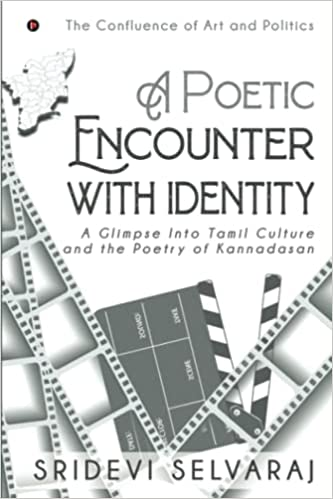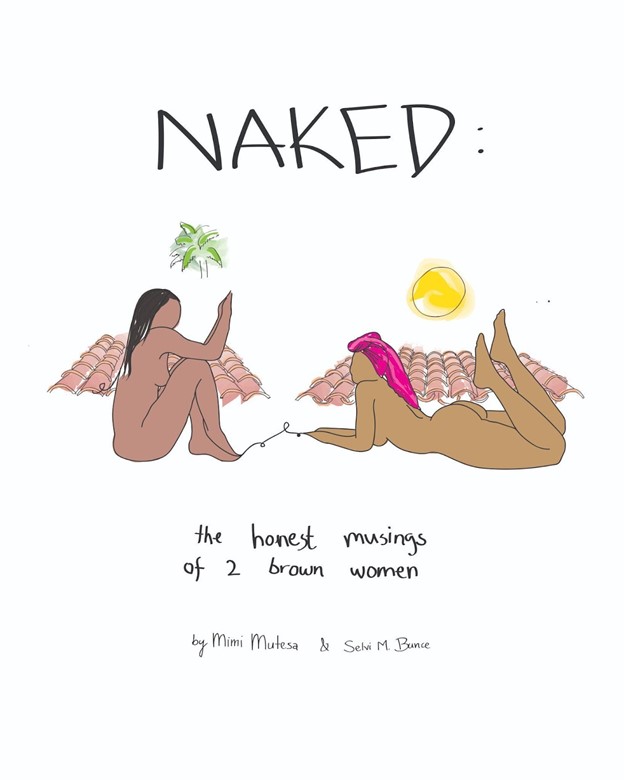Celebrate India!
Unity in Diversity!!
Click Here for Back Issues of Language in India - From 2001

Available in https://www.amazon.in/dp/B09TT86S4T

Naked: the honest browsings of two brown women
Available in https://www.amazon.in

Available in https://www.amazon.com
BOOKS FOR YOU TO READ AND DOWNLOAD FREE!
- SEMANTICS AND PRAGMATICS
A Monograph - Textbook in Tamil ...
Prof. Rajendran Sankaravelayuthan - WordNet and its dimensions -- A Textbook in Tamil ...
Prof. Rajendran Sankaravelayuthan - GENERAL LINGUISTICS -- Tamil Textbook ...
Prof. Rajendran Sankaravelayuthan - Silent Talk
Nonverbal Communication ...
M. S. Thirumalai, Ph.D. - Jayampu krishna kathalu � parisilana
A dissertation submitted to the University of Madras for the partial fulfillment of the award of the M.Phil. Degree in Telugu ... Thulluru Ravi - Corpus Linguistics -- A Monograph in Tamil ... Prof. Rajendran Sankaravelayuthan
- A TRANSFER GRAMMAR FOR ENGLISH-TAMIL MACHINE TRANSLATION
... Prof. Rajendran Sankaravelayuthan
Dr. P. Kumaresan - AN INTRODUCTORY COURSE ON SEMANTICS AND PRAGMATICS ...
Prof. Rajendran Sankaravelayuthan - Nuances of Making Spell and Grammar Checker for Tamil
Monograph in Tamil ...
Prof. Rajendran Sankaravelayuthan
Dr. R. Amutha - COMPUTATIONAL LINGUISTICS
A Monograph in Tamil (Tamil) ...
Prof. Rajendran Sankaravelayuthan - Using Theatre To Enhance Learner Language In English Classrooms:
A Sri Lankan Experiment � Ph.D. Dissertation ...
Kandiah Shriganeshan, Ph.D. - Acoustic Phonetics and Text to Speech Processing and
Speech to Text Processing (Tamil) � Monograph ...
Prof. Rajendran Sankaravelayuthan - Aspects of Vowels Analysis for Speech & Hearing
Diagnostics
Volume 2 ...
Gayathri S G., MSc (Speech& Hearing), PGD Nutrition and Dietetics - Aspects of Vowels Analysis for Speech & Hearing
Diagnostics
Volume 1 ...
Gayathri S G., MSc (Speech& Hearing), PGD Nutrition and Dietetics - Word Sense Disambiguation in Tamil ...
Prof. Rajendran Sankaravelayuthan and Dr. A. Dhanavalli - Semantic Intention and Semantic Relation in Children with
Intellectual Disability and Hearing Impairment -- Masters Dissertation ...
Nithina Alice Boban and Satish Kumaraswamy - Ontology of Tamil Vocabulary
A Detailed Study of Form and Function of Tamil Vocabulary ...
Prof. Rajendran Sankaravelayuthan and K. Anithaa, Ph.D. - A Historical Linguistic Study of Tamil Nouns ...
Prof. Rajendran Sankaravelayuthan and Dr. S. Tamilselvam - Semantic Change and Semantic Extension of Tamil Verbs
A Research Monograph (in Tamil) ...
Prof. Rajendran Sankaravelayuthan
Dr. K. Bakkiyaraj - Greening the Young Mind:
Eco-consciousness in Contemporary English Language Fiction for Children and Young Adults in India ...
Dr. Shobha Ramaswamy, M.A., B.Ed., DCE, M.Phil., Ph.D. - English To Tamil Machine Translation System Using Parallel Corpus ...
Prof. Rajendran Sankaravelayuthan
Dr. G. Vasuki - Bharathiar University
Coimbatore 641046, Tamilnadu, India
Department of English and Foreign Languages Dr. V. David Arputha Raj, M.A., M.Phil., Ph.D., Editor
Trends in Select Sahitya Akademi Award-winning Tamil Novels - Word Order Typology and Its Implication in Translation ...
Prof. Rajendran Sankaravelayuthan
Dr. N. Gejeswari - Select Papers from International Conference on Contemporary Issues in Language and Literature,
Thanthai Hans Roever College (Autonomous)
Elambalur, Perambalur - 621 220 Tamilnadu, India ...
Editor: K. Nesapriya, Editor - Select Papers of the National Conference on Effective Strategies, Innovative Methods & Integrated Pedagogical Approaches to Learning and Teaching English in Heterogenous Classrooms,
SRM Valliammai Engineering College, Kattankulathur 603 303, Tamilnadu, India ...
Editors: Prof N.Lakshmana Perumal,
Sheeba Manodh and M.Chithra - Insight into Select Literary Works ...
Editor: Dr. S. Jayanthi, M.A., M.Phil., Ph.D. - Periyar University
Department of English, Salem, Tamilnadu, India
Papers presented in the National Seminar
Food is not just a Curry: Raison de'tre of Food in Literature - FDLT 2019 ...
Editors: Dr. V. Sangeetha, Dr. B. J. Geetha,
Dr. K. Sindhu, Dr. S. Boopathi and
Ms. S. Snekha Sri - Sri S. Ramasamy Naidu Memorial College
Sattur 626203, Tamilnadu, India
Select Papers of the International Conference on Translation:
Exploring the Nuances and Possibilities of Mediating Intercultural Texts ...
Dr. S. Jayanthi, M.A., M.Phil., Ph.D., Editor - St. Joseph�s College for Women, Tirupur, Tamilnadu
Select Papers from the Conference
Reading the Nation � The Global Perspective ...
R. Rajalakshmi, Editor - From Leadership Competencies To Leaderful Practices At
Mahatma Gandhi Institute (MGI) �
Ph.D. Dissertation, Leeds Metropolitan University ...
Dr. Veedotma D. Koonjal - Select Papers from the National Conference on Challenges and Opportunities for
Teaching and Research in English Language and Literature, March 23, 2018
Vellore Institute of Technology, Chennai Campus
Division of Social Sciences and Languages, Department of English ...
Dr. V. Rajasekaran, Editor - NEW PERSPECTIVES IN ELT 2018
Selected Papers from the National Seminar on New Perspectives in ELT
Conducted by the Department of English
Theni Kammavar Sangam College of Technology, Theni 625534
Tamilnadu, India ...
Editors: D. Nagarathinam, Ph.D., and R. Vani, M.A., M.Phil. - Annamalai University
Department of English
Select Papers from the National Seminar on Subaltern Literature:
Resistance and Reconstruction
Indian Writing in English: A Subaltern Perspective
...
Editor: Dr. T. DeivasigamaniBlack Writings: A Subaltern Perspective
...
Editor: Dr. T. Deivasigamani - English Language, Literature & Culture
Select Papers of the Second National Conference on English Language, Literature & Culture
Kongunadu College of Engineering & Technology, Thottiyam, Tamilnadu, India ...
Editor: Ms. T. Vembu, M.A., M.Phil., B.Ed., (Ph.D.) - Teaching of Language and Literature ... Dr. Dr. S. Jayanthi, M.A., M.Phil., Ph.D., Editor
- Language Learning and Teaching ... Dr. S. D. Sasi Kiran and Dr. A. Sharada, Editors
- Building A Global Village (GV) Through Inter Dialogue ... Dr. S. D. Sasi Kiran and Dr. A. Sharada, Editors
- Contemporary Literary Perspectives ... Dr. A. Sharada and Dr. S. D. Sasi Kiran, Editors
- The Superhuman Character of Nature Playing Superlative Role in William Wordsworth�s Poems
M.A. Dissertation
Rajshahi Science and Technology University, Natore ... Mohammad Sultan Ferdous Bahar, M.A. - PROBLEMS IN TEACHING ENGLISH IN SECONDARY SCHOOLS IN NORTH TRIPURA DISTRICT
M.Phil. Dissertation
SAVITRIBAI PHULE PUNE UNIVERSITY ... MALAY NATH, M.A., M.Phil. - The Speech Act of Compliment Response as Realized by Yemeni
Arabic Speakers
Masters Dissertation
University of Kerala ... Ameen Ali Mohammed Al-Gamal - CHALLENGES FACED BY STUDENTS IN LEARNING ENGLISH IN GRADES 11 AND 12 IN
BANGLADESHI MADRASAHS
Masters Dissertation
London Metropolitan University ... Muhammad Nazmul Huda Azad - Gender Conflicts as Evident in Contemporary English Literature o ... Editor: Dr. R. Anuja
- English: Literature and Social Issues ... Editor: T. Vembu, M.A., M.Phil., B.Ed., (Ph.D.)
- From financial literacy to financial well being;
a study of the level of financial literacy of women teaching faculty
in educational institutions in Coimbatore region
Doctoral Dissertation ... S. Hephzibah Priyadharshini, Ph.D. - Language Development Strategies in the Era of Globalization: Telugu
National Seminar Proceedings
University of Hyderabad ... Editor: Dr. Pammi Pavan Kumar - Using English Literature in Higher Secondary EFL Classrooms in Rural Bangladesh:
Bridging the Cultures to Facilitate EFL Learning
M.A. Dissertation ... Mossa. Sohana Khatun, M.A. - Washback of the Public Examination on Teaching and
Learning English as a Foreign Language (EFL) at
the Higher Secondary Level in Bangladesh
Ph.D. Dissertation ... Md. Enamul Hoque, Ph.D. - Investigating Students� Listening and Speaking Communication and
Perceptions through the Implementation of Chinese Culture Content-Based Course
Masters Dissertation ... Xingchun Wang - NEW PERSPECTIVES IN ELT
Selected Papers from the National Seminar on New Perspectives in ELT
Conducted by the Department of English
Theni Kammavar Sangam College of Technology, Theni 625534
Tamilnadu, India ...
Editors: D. Nagarathinam, Ph.D., V. Ramkumar, Ph.D. and R. Vani, M.A., M.Phil. - Causes for the Failure of Students in Developing Writing Skills at the HSC Level in Bangladesh
Masters Dissertation ... Sukanto Roy, M.A. in ELT - Selected Papers from
the National Seminar NEW VISTAS IN ELT:
EMPOWERING ENGINEERS FOR EMPLOYMENT
Conducted by the Department of English
PSNA College of Engineering and Technology, Dindigul-624622 Tamilnadu, India ...
Editors:
Dr. Joseph Thomas, Ph.D.
G. Vijay, M.A., M.Phil.
Mrs. Shabnam Niher, M.A., M.Phil. - Bubhutsa
An Anthology of Essays in Telugu on
Language Development and Planning,
Computer Applications and Methods and Evaluation of Language Teaching ...
Dr. Pammi Pavan Kumar - An Optimistic Evolution of Existence in Saffron Dreams by Shaila Abdullah ... Rabia Ashraf, M.Phil., B.S. (Hons.)
- FICTION FOR CHILDREN AND YOUNG ADULTS IN INDIA:
CRITICAL ESSAYS ... Dr. Shobha Ramaswamy, M.A., B.Ed., DCE, M.Phil., Ph.D. - OPINION OF THE HIGH SCHOOL TEACHERS ABOUT THE CANCELLATION OF THE SSLC EXAMINATION
M.Ed. Dissertation ... M. Raj Kumar, M.A., M.Ed. - SURVIVAL THROUGH REDEMPTION OF SELF IN THE SELECT NOVELS OF ALICE WALKER ... N. R. CHARRUMATHI, M.A.., M.Phil., Ph.D.
- Evil, Sin and Suffering in the Select Novels of Graham Greene ... Suma Aleya John, M.A., M.Phil., Ph.D.
- Images of Women in R. K. Narayan�s The Dark Room ... C. Malathi, M.A., M.Phil., NET, Ph.D. Candidate
- Error Analysis and Paragraph Writing ...
Ali Akbar Khansir, Ph.D.
Masomeh Ahrami, M.A. - ENGLISH AS A SECOND LANGUAGE -
PROFICIENCY ISSUES OF JAFFNA STUDENTS
(Prescribed as a Text Book for University Undergraduates) ... Dr. V. Suntharesan, Ph.D. - A Study of Elementary School Thai English Teachers' Perceived English Proficiency And Self Reported English Teaching Efficacy ... Barbara Best, MA TESOL
- IMPACT OF BORROWINGS FROM ENGLISH ON
JAFFNA TAMIL
(A Text Book For University Students) ... Dr. V. SUNTHARESAN, Ph.D. - An Exploratory Study into Factors Affecting Achievement in
English among Bangladeshi College Students:
An Investigation of Teachers and Students Perceptions ... Mohammad Mahbubur Rahman, M.A. in TESOL - The Role of Motivation in Teaching and Learning English as a Second Language at the Secondary Level ... Mosha. Afroza Sultana
- Teaching-Learning English Grammar Papers Presented in the 10th International Conference on English Grammar - Vol. 2 ... Editor: Dr. Vathana Fenn
- Teaching-Learning English Grammar Papers Presented in the 10th International Conference on English Grammar - Vol. 1 ... Editor: Dr. Vathana Fenn
- IMPEDIMENTS IN PROMOTING
COMMUNICATIVE COMPETENCE AMONG
STUDENTS OF ENGLISH AS A SECOND LANGUAGE ...
V. Suntharesan, Ph.D. - ARCHETYPES IN FANTASY FICTION: A STUDY OF J. R. R. TOLKIEN AND J. K. ROWLING ... Dr. Shobha Ramaswamy, M.A., B.Ed., DCE, M.Phil., Ph.D.
- Writing Problems among the Tertiary Level Students in Bangladesh: A Study in Chittagong Region ... Shakila Mustaque, M.A. in English and M.A. in ELT
- A Sociolinguistic Study of Social Stratification in Bangladesh and Its Impact on Academic Performance in English at Secondary Level Education ... Md. Abdur Rashid, M.A. in English and M.A. in ELT
- Sri Gidugu Venkata Ramamurti�s Life and His Works
Papers Read in the National Seminar to Celebrate the 150th Anniversary of G. V. Ramamurtigaru ... Chief Editor Dr. Pammi Pavan Kumar
Co-editor Dr. Banala Bhujanga Reddy
Honorary Editor Prof. S. Saratjyotsna Rani - The Impact of Teachers� Beliefs on L2 Grammar Teaching ...
Nayyer Hassan, M.A. TESOL, M.S. TESOL - Tribal Languages of Kerala ...
Ravi Sankar S. Nair, Ph.D. - Teaching of Adverbials to the Tamil Speaking Learners of English ...
S. Rajendran - Drama in Indian Writing in English - Tradition and Modernity ...
Dr. (Mrs.) N. Velmani, Ph.D. - Representation of History in Rahi Masoom Reza�s A Village Divided and
Amitav Ghosh�s The Glass Palace
M.Phil. Dissertation ...
Imran A.K. Surti - Personality Style, Anxiety Sensitivity and Perceived
Social Support among the Pregnant Women
M.Phil. Dissertation in Clinical Psychology ...
Mangaleshwari Manjari. N. M.Sc., M.Phil. - Health and Medical Care Services: Claims on National
Resources ...
Editor: C. Subburaman, Ph.D. - An Investigation into Some of the Learning Problems in
English Language Writing among Lambada Community Learners
in Andhra Pradesh ...
N. Padmamma, M.Phil. - Teaching Writing Using Picture Stories as Tools at the High School Level: The Movement from Other Regulation to Self Regulation ...
Y. Nirmala, M.Phil. - Current Perspectives on Education ...
Editors: P. Udayakumar, M.Sc., M.Phil., M.Ed., M.A., Ph.D. Candidate
Dr. M. Lekeshmanaswamy, Ph.D.
Dr. K. Dhanalakshmi, Ph.D. - Acoustic Characteristics of Vowels in Telugu ...
Krishna. Y. - Mother � Daughter Relationships: A Study of The Dark Holds No Terrors, Difficult Daughters and Fasting, Feasting ...
Jitender Singh, M.A., M.Phil., NET. - Treatment of Violence: A Study of Morrison�s The Bluest Eye and Beloved
...
Shubhanku Kochar, M.Phil., Ph.D. Candidate - Dyslexia: A Critical Study of Language Deficiency in Children and Adolescents
...
Vaishali Narbheram Punjani, M.A., M.Phil. B.Ed. - Michael Ondaatje�s Anil�s Ghost and Vikram Chandra�s Sacred Games as Detective Fiction
...
S. Sridevi, M.A., M.Phil., B.Ed. - A Grammar of Malayalam ...
Ravi Sankar S Nair, Ph.D. - The Evolution of Language Laws in Post-Independence India ...
B. Mallikarjun, Ph.D. - Impact of Commercialization on Language with Special Reference to Urdu Lexicon - Doctoral Dissertation ... Somana Fatimah,Ph.D.
- Status of English among the Kokborok and Tripura Bangla Learners in Tripura - M.Phi. Dissertation ... Swapan Debnath, M.A., M.Phil., Ph.D.
- Communicative Language Teaching Approach at Higher Secondary Level in Bangladesh � Teachers� Perceptions and Classroom Practice ... Md. Khaled Bin Chowdhury, M.A. (Double)
- A Study on Personality Factors Causing Stress among School Teachers
M.Phil. Dissertation ... C. Manjula, M.A., M.Phil., Ph.D. - English Language Teaching
Updating the English Classroom with Techniques and Communication Skills
A Book on Current ELT ... Chandrika Mohan, M.A., M.A., M.Phil., C.G.T., Ph.D. Candidate - A Song for the Road-
Wole Soyinka�s Imagery and Tradition ... V. N. Manjula, Ph.D. - A Linguistic Survey of Katta Varadaraju�s Dwipada Ramayanam
A Ph.D. Dissertation in Telugu ... Pammi Pavan Kumar, M.A. (Telugu) M.A. (Linguistics), M. Phil., Ph.D. (Telugu) - Select Speeches of Mrs. Indira Gandhi
English to Tamil
M.Phil. Dissertation ... J. Abiraami, M.A., M.Phil. - Linguistics and Literature, Department of Linguistics Silver Jubilee Volume 1 ... Editors: C. Sivashanmugam, Ph.D., et al.
- Recent Advances in Linguistics, Department of Linguistics Silver Jubilee Volume 2 ... Editors: C. Sivashanmugam, Ph.D., et al.
- Engineering English: A Critical Evaluation - Ph.D. Dissertation ... Albert P�Rayan, Ph.D.
- Kalidasa's Shakuntala and the Doctrine of Rasa ... Tripti Mund, M.A., M.Phil.
- Evolving Strategies for Teaching Basic Vocabulary in L2 through Meaningful Input: An Ethnographic Study with First Generation Learners ... Rajakumar Guduru, M.Phil., Ph.D. Scholar
- Aspects of Autobiography in Indian Writing in English ... Editors: Pauline Das, Ph.D., K. R. Vijaya Murari, Ph.D., and Charu Sheela, M.A., M.Phil., M.B.A.
- Imagery in Donne's Songs and Sonnets ... Fatima Ali al-Khamisi, M.A.
- Parsing in Indian Languages ... Editors: Kommaluri Vijayanand and L. Ramamoorthy
- English Language Teaching (ELT) in Saudi Arabia: A Study of Learners' Needs Analysis with Special Reference to Community College, Najran University ... Dr. Mohd. Mahib ur Rahman, Ph.D.
- Provision for Linguistic Diversity and Linguistic Minorities in India ... Vanishree V.M., MAPL and ELT, M.A., PGDHRM.
- Impact of Students' Attitudes on their Achievement in English: A Study in the Yemeni Context ... Hassan Saeed Awadh Ba-Udhan
- A Study of B.ED. Students' Attitude Towards Using Internet in Vellore District, Tamilnadu, India ... T. Pushpanathan, M.A., M.Phil., B.Ed.
- Development of a Hindi to Punjabi Machine Translation System, A Doctoral Dissertation ... Vishal Goyal, Ph.D.
- A Report on the State of Urdu Literacy in India, 2010 ...
Omar Khalidi, Ph.D. - English for Medical Students of Hodeidah University, Yemen - A Pre-sessional Course ...
Arif Ahmed Mohammed Hassan Al-Ahdal, Ph.D. Scholar - Global Perspective of Teaching English Literature in Higher Education in Pakistan ...
Rabiah Rustam, M.S., Ph.D. Candidate - Improving Chemmozhi Learning and Teaching - Descriptive Studies in Classical-Modern Tamil Grammar ...
A. Boologa Rambai, Ph.D. - A Phonetic and Phonological Study of the Consonants of English and Arabic ... Abdulghani A. Al-Hattami, Ph.D. Candidate
- Some Aspects of Teaching-Learning English as a Second Language ...
R. Krishnaveni, M.A., M.Sc., M.Phil., Ph.D. Candidate - The Influence of First Language Grammar (L1) on the English Language (L2) Writing of Tamil School Students: A Case Study from Malaysia ...
Mahendran Maniam, Ph.D. (ESL) - Economics of Crime : A Comparative Analysis of the Socio-Economic Conditions of Convicted Female and Male Criminality In Selected Prisons in Tamil Nadu ...
S. Santhanalakshmi, Ph.D. - Technique as Voyage of Discovery: A Study of the Techniques in Dante's Paradiso ...
Raji Narasimhan, M.A. - A Critical Study of The Wasteland - Poetry as Metaphor ...
K. R. Vijaya, M.A., M.Phil. - Language and Literature: An Exposition - Papers Presented in the Karunya University National Seminar ... Editor: J. Sundar Singh, Ph.D.
- Linguistic Purism and Language Planning in a Multilingual Context ...
L. Ramamoorthy, Ph.D. - Papers Presented in the All-India Conference on Multimedia Enhanced Language Teaching - MELT 2009 ...
L. Ramamoorthy, Ph.D. and J.R. Nirmala, Ph.D. - A Phonological Study of Variety of English Spoken by Oriya Speakers in Western Orissa - A Doctoral Dissertation ... Arun K. Behera, Ph.D.
- Phonological Analysis of English Phonotactics of Syllable Initial and Final Consonant Clusters by Yemeni Speakers of English ... Abdulghani. M. A. Al-Shuaibi, M.A.
- Journey of Self-discovery in Anita Nair's Ladies' Coup� ... V. Chandra, M.A.
- The Literary Value of the Book of Isaiah ... Helen Unius Backiavathy, M.A.,M.Phil., Ph.D. Candidate
- A Study of Structural Duplication in Tamil and Telugu - A Doctoral Dissertation ... Parimalagantham, Ph.D.
- The Politics of Survival in the Novels of Margaret Atwood ... Pauline Das, Ph.D.
- Nonverbal Communication in Tamil Novels - A Book in Tamil ...
M. S. Thirumalai, Ph.D. - A Study of English Loan Words in Selected Bahasa Melayu Newspaper Articles...
Shamimah Binti Haja Mohideen, M.HSc. (TESL) - The Internal Landscape and the Existential Agony of Women in Anjana Appachana's Novel LISTENING NOW, A Doctoral Dissertation ...
M. Poonkodi, Ph.D. - Trade in the Madras Presidency, 1941 - 1947 - A Doctoral Dissertation ...
R. Jayasurya, Ph.D. - Trends and Spatial Patterns of Crime in India - A Case Study of a District in India ...
M. Jayamala, Ph.D. - The Trading Community in Early Tamil Society Up To 900 AD ...
R. Jeyasurya, M.A., M.Phil., Ph.D. - A Study of Auxiliaries in the Old and the Middle Tamil ...
A.Boologarambai, M.A., Ph.D. - History of Growth and Reforms of British Military Administration in India, 1848-1949 ...
Hemalatha, M.A., M.Phil. - Language of Mass Media: A Study Based on Malayalam Broadcasts - A Doctoral Dissertation
K. Parameswaran, Ph.D. - Form and Function of Disorders in Verbal Narratives - A Doctoral Dissertation ...
Kandala Srinivasacharya, Ph.D. - Status Marking in Tamil - A Ph.D. Dissertation
P. Perumalsamy, Ph.D. - LANGUAGE AND POWER IN COMMUNICATION ...
Editors: Jennifer M. Bayer, Ph.D., and Pushpa Pai, Ph.D. - Onomatopoeia in Tamil ...
V. Gnanasundaram, Ph.D. - Linguistics and Literature ...
C.Shunmugom, Ph.D., and C. Sivashanmugam, Ph.D., V. Thayalan, Ph.D. and C. Sivakumar, Ph.D. (Editors) - Translation: New Dimensions ...
C.Shunmugom, Ph.D., and C. Sivashanmugam, Ph.D., Editors - Language of Headlines in Kannada Dailies ...
M. N. Leelavathi, Ph.D. - Cooperative Learning Incorporating Computer-Mediated Communication: Participation, Perceptions, and Learning Outcomes in a Deaf Education Classroom ...
Michelle Pandian, M.S. - The Effects of Age on the Ability to Learn English As a Second Language ... Mariam Dadabhai, B.A. Hons.
- A STUDY OF THE SKILLS OF READING COMPREHENSION IN ENGLISH DEVELOPED BY STUDENTS OF STANDARD IX IN THE SCHOOLS IN TUTICORIN DISTRICT, TAMILNADU ...
A. Joycilin Shermila, Ph.D. - A Socio-Pragmatic Comparative Study of Ostensible Invitations in English and Farsi ...
Mohammad Ali Salmani-Nodoushan, Ph.D. - TEXT FAMILIARITY, READING TASKS, AND ESP TEST PERFORMANCE: A STUDY ON IRANIAN LEP AND NON-LEP UNIVERSITY STUDENTS - A DOCTORAL DISSERTATION ...
Mohammad Ali Salmani-Nodoushan, Ph.D. - A STUDY ON THE LEARNING PROCESS OF ENGLISH
BY HIGHER SECONDARY STUDENTS
WITH SPECIAL REFERENCE TO DHARMAPURI DISTRICT IN TAMILNADU
K. Chidambaram, Ph.D. - SPEAKING STRATEGIES TO OVERCOME COMMUNICATION DIFFICULTIES IN THE TARGET LANGUAGE SITUATION - BANGLADESHIS IN NEW ZEALAND ...
Harunur Rashid Khan - THE PROBLEMS IN LEARNING MODAL AUXILIARY VERBS IN ENGLISH AT HIGH SCHOOL LEVEL ...
Chandra Bose, Ph.D. Candidate - THE ROLE OF VISION IN LANGUAGE LEARNING in Children with Moderate to Severe Disabilities ...
Martha Louise Low, Ph.D. - SANSKRIT TO ENGLISH TRANSLATOR ...
S. Aparna, M.Sc. - A LINGUISTIC STUDY OF ENGLISH LANGUAGE CURRICULUM AT THE SECONDARY LEVEL IN BANGLADESH - A COMMUNICATIVE APPROACH TO CURRICULUM DEVELOPMENT by
Kamrul Hasan, Ph.D. - COMMUNICATION VIA EYE AND FACE in Indian Contexts by M. S. Thirumalai, Ph.D.
- COMMUNICATION VIA GESTURE - Indian Contexts by
M. S. Thirumalai, Ph.D. - CIEFL Occasional Papers in Linguistics, Vol. 10
- Language Acquisition, Thought and Disorder - Some Classic Positions by
M. S. Thirumalai, Ph.D. - English in India: Loyalty and Attitudes by
Annika Hohenthal - Language In Science by
M. S. Thirumalai, Ph.D. - Vocabulary Education by
B. Mallikarjun, Ph.D. - A Contrastive Analysis of Hindi and Malayalam by
V. Geethakumary, Ph.D. - Language of Advertisements in Tamil Mass Media by
Sandhya Nayak, Ph.D. - An Introduction to TESOL: Teaching English to Speakers of Other Languages by
M. S. Thirumalai, Ph.D. - Transformation of Natural Language into Indexing Language: Kannada - A Case Study by B. A. Sharada, Ph.D.
- How to Learn Another Language? by M.S.Thirumalai, Ph.D.
- Verbal Communication with CP Children by Shyamala Chengappa, Ph.D. and M.S.Thirumalai, Ph.D.
- Bringing Order to Linguistic Diversity - Language Planning in the British Raj by
Ranjit Singh Rangila,
M. S. Thirumalai,
and B. Mallikarjun
Girish Karnad as a Modern Indian Dramatist - A Study ...
B. Reena, M.A., M.Phil.
REFERENCE MATERIALS
- National Education Policy 2020
Ministry of HRD, Government of India - Some Inputs for Draft National Education Policy 2016
Ministry of Human Resource Development
Government of India - Tamilnadu State Policy for Children, Government of Tamilnadu
- CENSUS OF INDIA 2011 General Data
- CENSUS OF INDIA 2011 DATA ON DISABILITY
- Action Plan of Centre for Classical Kannada
- UNIVERSAL DECLARATION OF LINGUISTIC RIGHTS
- Lord Macaulay and
His Minute on
Indian Education - In Defense of
Indian Vernaculars
Against
Lord Macaulay's Minute
By A Contemporary of
Lord Macaulay - Languages of India,
Census of India 1991 - Mother Tongues of India,
According to
1961 Census of India - The Constitution of India:
Provisions Relating to
Languages - The Official
Languages Act, 1963
(As Amended 1967)
BACK ISSUES
- E-mail your articles and book-length reports in Microsoft Word to languageinindiaUSA@gmail.com.
- PLEASE READ THE GUIDELINES GIVEN IN HOME PAGE IMMEDIATELY AFTER THE LIST OF CONTENTS.
- Your articles and book-length reports should be written following the APA, MLA, LSA, or IJDL Stylesheet.
- The Editorial Board has the right to accept, reject, or suggest modifications to the articles submitted for publication, and to make suitable stylistic adjustments. High quality, academic integrity, ethics and morals are
expected from the authors and discussants.
Copyright © 2023
M. S. Thirumalai
Publisher: M. S. Thirumalai, Ph.D.
11249 Oregon Circle
Bloomington, MN 55438
USA
Custom Search
Grammatical Gender: An Overview of Gender Assignment in Garhwali
Saket Bahuguna
Abstract
This paper examines the grammatical gender assignment system in Garhwali using both phonological and semantic principles. In the semantic assignment rules of the language, it is determined that the nouns for sex-differentiable male humans, male animals, and male deities in Garhwali are masculine, while the nouns for sex-differentiable female humans, female animals, and female deities are feminine. The assignment of all the nouns in the language cannot be explained by these semantic assignment rules alone and results in a large residue of nouns which are analyzed through the phonological assignment rules. According to this study�s findings, most nouns ending in front unrounded vowels in Garhwali are feminine except those ending in /i/. In contrast, the majority of those ending in back rounded vowels and the back unrounded vowel /a/ are masculine.
Keywords: Grammatical Gender, Gender Assignment, Indo-Aryan, Central Pahari, Garhwali
Introduction
According to Hockett (1958:231), grammatical gender is defined as classes of nouns that are mirrored in the behaviour of related words. As stated by Corbett (1991: 1), this categorization of grammatical gender often, though not always, correlates to a real-world sex distinction, at least in part. According to Kramer (2020: 46), grammatical gender is the categorization of nouns into two or more classes based on criteria such as animacy, humanness, social gender for people, and/or biological sex for animals, or both, for at least some animate noun and reflected by agreement patterns on other elements. Therefore, agreement is a crucial concept in grammatical gender. The existence of grammatical gender and the number of genders in a language are proven by evidence of agreement, implying that grammatical gender depends on the form. However, grammatical gender has a �semantic core� (Aksenov 1984 cited in Corbett 1991) and is not solely dependent on form. As a result, even though their precise functions vary from language to language, we may argue that gender is concerned with both form and meaning. Grammatical gender can be determined in certain languages solely by meaning, whereas in others, it can be determined by a combination of both meaning and form.
Gender Assignment
How do native speakers of a language determine the grammatical gender of hundreds of Nouns? Both linguists and non-linguists have always considered this subject to be intriguing. Corbett (1991: 7) states that native speakers are able to systematically assign nouns a grammatical gender. He offers three justifications for this. First, it is acceptable to presume that native speakers do not remember the nouns individually since else they would make more mistakes in gender usage. Second, words that have been acquired from other languages take on gender, demonstrating that gender may be assigned and not only remembered. Third, speakers assign invented words gender and do so with a high degree of precision. Native speakers are, therefore, able to assign grammatical gender to nouns in a systematic way.
Saket Bahuguna
National Council of Educational Research and Training, New Delhi
saketbahugunadu@gmail.com
- Click Here to Access All the Papers of May 2023 Issue
- Click Here for the PRINT VERSION OF ALL THE PAPERS OF MAY 2023 ISSUE IN BOOK FORMAT.
- Click Here for Back Issues of Language in India
- Click Here for the HOME PAGE of Language in India
- CONTACT PUBLISHER languageinindiaUSA@gmail.com
Custom Search
- Click Here to Go to Creative Writing Section
- Send your articles
as an attachment
to your e-mail to
languageinindiaUSA@gmail.com. - Please ensure that your name, academic degrees, institutional affiliation and institutional address, and your e-mail address are all given in the first page of your article. Also include a declaration that your article or work submitted for publication in LANGUAGE IN INDIA is an original work by you and that you have duly acknowledged the work or works of others you used in writing your articles, etc. Remember that by maintaining academic integrity we not only do the right thing but also help the growth, development and recognition of Indian/South Asian scholarship.

